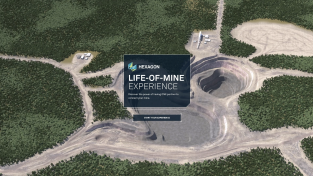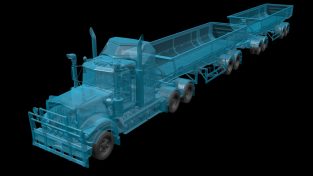As we celebrate the 50th anniversary of MinePlan, geologist Neb Žurkić tells us how he has been using the software for 27 years to help smart mines with deposit modeling, resource estimation, ore control and technical auditing.
NJ: For 50 years, geologists and engineers worldwide have used Hexagon’s MinePlan Software for design, modelling, scheduling and operations. For more than half that time consultant Neb Žurkić has used MinePlan to help his clients solve their toughest challenges at the surface and below it.
Thanks for tuning in. Hi, I’m Neville Judd from Hexagon Radio. Since 1970, Hexagon’s mine planning solution MinePlan has been helping companies with design, modelling, scheduling and operations. For 27 years Geologist Neb Žurkić has been using MinePlan as Director of Žurkić Mining Consultants. From his company base in Melbourne, Australia Neb helps clients in some of the world’s biggest mines with deposit modelling, resource estimation, ore control and technical auditing. Neb, thanks for joining us today.
NZ: Thanks, Neville.
NJ: So, Neb, your work has taken you all over the world. Tell us about Žurkić Mining Consultants and the work you do for mines.
NZ: We’re sort of a pretty small group. Part of a larger loosely affiliated group of associates. The structure like that sort of helps us keep the cost down for clients so we’re sort of accessible to even the smallest of exploration companies. So, we just draw on whoever’s available for what we need. We do most things. We can do things from planning and managing drill programmes to right through feasibility studies, grade control, improving practises after the operations have started and things like that.
NJ: Describe some of the bigger or more complex projects that you’ve been involved with over the years.
NZ: Sure. Outside of full-blown feasibility studies most of the work we tend to do is fixing up underlying input data to use in the software. As we all know, most people are familiar with the GIGO (Garbage In, Garbage Out) acronym. There isn’t any software that can fix that so to get the most out of what we’re doing and the software and the math and everything that we do, we spend a lot of time on fixing input data. Sampling quality and all that sort of thing and I guess the most notable example of that is that we added four million ounces to a resource estimate without even drilling the hole. The project was a big project to start with but adding that sort of quantum of ounces to any project is significant to the business.
NJ: So, you’ve been using MinePlan, formally known as MineSight and Medsystems before that, for 27 years. Tell us how the software has changed during that time in your experience.
NZ: I guess that establishes how old I am. Actually, I’ve been using it ever since they called it, it used to be called Medsystems at one point. Back in the days when visualisation was in VBM land and we used to generate wire frames in the old 670 executables. It was a pretty clunky system back then. It would fail 4 out of 5 times but unlike today when everybody has a wire frame of their ore body, back then it was pretty rare so you’d sort of persevere with the thing and it was pretty cool to have a wireframe back then. But look, then came MineSight in the mid 90’s and that was revolutionary. Probably the closest thing I could compare it to was probably a decade after that where we first played with an iPhone. It was that sort of thing, so it was quite a big difference when MineSight came along at that time.
NJ: So, there are a lot of software solutions on the market. Why do you use MinePlan?
NZ: I started with it. I’ve worked for mainstream consultancies and pretty large US-based gold company at one point. So, I’ve seen most of your competitors, I guess. When I say seen I’ve had a pretty good look at it and it’s not me driving it as the other software as non-proficient user but looking at people who can drive that other software and to be fair in my assessment there are probably two or three that can compete. The rest don’t compete and of those two or three maybe it’s a comfort thing in the end. You get comfortable with one of them. Support was a big thing. Support was always a big thing way back when it first appeared in Australia through the Mintec Company. So, support’s probably one of the big things why I would use MineSight. MinePlan, sorry.
NJ: So, teamwork is important in any business and I would think especially in mining. Tell me a little bit about how the integration of MinePlan solutions help engineers and geologist collaborate.
NZ: A good example of that would be one of the associates that I previously mentioned that I worked with is a mining engineer. We did work together for a company and MinePlan wasn’t his first choice. It was one of your competitors and he was a staunch critic of MinePlan and this was probably late 90’s. When we came to work together in this format as associates, and this is no encouragement from myself, but he became a MinePlan user. It just became very easy for us to work like that. Specifically, again I can’t tell you exactly what that is but for somebody to sort of transfer over it was interesting for me to view that because he was quite a critic at the time. So, whether it’s something that you guys did progressively, I think it might have been that. That’s probably the best example I can give you of that.
NJ: So, 27 years, that’s a long time. What are some of the improvements you’ve seen in the software over that time?
NZ: Probably the biggest one was just transitioning from a command-driven, file-based system, into a windows-based system. That was the biggest one. Just getting everything into one spot and doing everything in one area. For example, right at this moment I’m doing some pretty high-end geo stats. Looking at some of the advanced geo statistics and running some conditional simulations for a nickel laterite. That, I had to do previously using some other piece of software and now that’s all sort of integrated into one spot and that sort of helped a lot, significantly. So, I don’t have to go and look for … and a lot of the other software that other people use, they have to do that. They have to go out and find a piece of software to attach to, go in and out, dump files and that helps a lot. I can do just about everything I want without doing that.
NJ: Neb, thanks so much for joining us today. I appreciate your insight and your candid responses. Thank you.
NZ: You’re welcome. Thanks, Neville.
NJ: So, a big thank you to our guest Neb Žurkić for joining us today. For more information about today’s topic visit hexagonmining.com and Žurkić-mining-consultants.com, and Žurkić is spelt Z-U-R-K-I-C. To listen to additional episodes or learn more, visit hxgnspotlight.com. Thanks for tuning in.
















